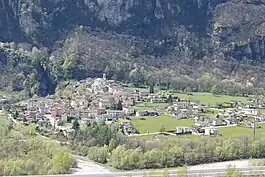Riviera | |
|---|---|
 Lodrino village | |
.svg.png.webp) Coat of arms | |
Location of Riviera | |
 Riviera  Riviera | |
| Coordinates: 46°19′N 8°59′E / 46.317°N 8.983°E | |
| Country | Switzerland |
| Canton | Ticino |
| District | Riviera |
| Government | |
| • Executive | Municipio with 7 members |
| • Mayor | Sindaco Alberto Pellanda FDP.The Liberals (as of June 2019) |
| • Parliament | Consiglio comunale with 31 members |
| Area | |
| • Total | 86.17 km2 (33.27 sq mi) |
| Elevation | 274 m (899 ft) |
| Population (31 December 2018)[1] | |
| • Total | 4,219 |
| • Density | 49/km2 (130/sq mi) |
| Time zone | UTC+01:00 (Central European Time) |
| • Summer (DST) | UTC+02:00 (Central European Summer Time) |
| Postal code(s) | 6527, 6703, 6705, 6707 |
| SFOS number | 5287 |
| Surrounded by | Personico, Biasca, Arvigo, Cauco, San Vittore, Claro, Moleno, Lavertezzo |
| Website | comuneriviera SFSO statistics |
Riviera (Italian pronunciation: [riˈvjɛ.ra] ⓘ) is a new municipality in the district of Riviera in the canton of Ticino in Switzerland. The municipalities of Osogna, Lodrino, Iragna and Cresciano merged on April 2, 2017.[2]
History
On October 18, 2015 the citizens of Osogna, Lodrino, Iragna and Cresciano voted to merge their municipalities into the new municipality of Riviera as the name of their district.[3] The merger was enacted by the Grand Council of Ticino.[4][5] The election of the municipal council marked the beginning of the new municipality.
Geography
The municipality is located in the Riviera district south of Biasca and north of Bellinzona on both banks of the Ticino. A recreation park is planned on these banks.[6]
The rocks of the region consist mainly of gneisses and granites (some quarries are operated in Lodrino). The vegetation is composed primarily of deciduous trees (beeches, chestnut trees) up to about 900 m (3,000 ft) and then evergreen trees (spruces and larches). Chestnuts were an important food for the population.
Demographics
The new municipality has a population (as of December 2020) of 4,252.[7]
Historic population
The historical population is given in the following chart:[8]

References
- ↑ "Ständige Wohnbevölkerung nach Staatsangehörigkeitskategorie Geschlecht und Gemeinde; Provisorische Jahresergebnisse; 2018". Federal Statistical Office. 9 April 2019. Retrieved 11 April 2019.
- ↑ Federal Statistical Office Retrieved April 2, 2017.
- ↑ Comunicato stampa Retrieved April 2, 2017
- ↑ Messaggio
- ↑ Decreto legislativo Retrieved September 11, 2017
- ↑ Rapporto della commissione di studio Retrieved September 11, 2017
- ↑ "Ständige und nichtständige Wohnbevölkerung nach institutionellen Gliederungen, Geburtsort und Staatsangehörigkeit". bfs.admin.ch (in German). Swiss Federal Statistical Office - STAT-TAB. 31 December 2020. Retrieved 21 September 2021.
- ↑ Swiss Federal Statistical Office STAT-TAB Bevölkerungsentwicklung nach institutionellen Gliederungen, 1850-2000 (in German) accessed 27 April 2016